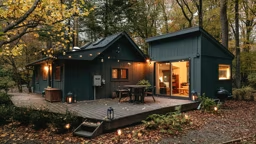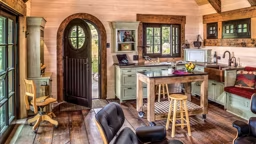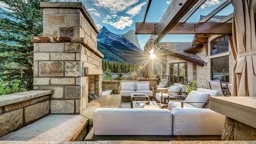Clinking ice cubes, a glorious red sunset, kids giggling over s’mores, fishing stories interrupted by bursts of laughter. … It’s a perfect evening on the cabin deck and everyone is having a wonderful time. Too bad you’re stuck inside preparing dinner.
Why not put yourself outside where the fun is with an outdoor kitchen?
Yes, we said outdoor kitchen. It doesn’t have to be expensive or elaborate or fussy. Chances are, you already have some of the components on your deck right now. An outdoor kitchen can be as simple as a charcoal grill, a table for dining and a storage cabinet that doubles as a food prep surface. Or it can be elaborate with a built-in grill, brick pizza oven, prep sink and weatherized wine cooler – all under a vine-covered pergola.
The important thing is to gather everything you need to produce meals for your guests. It’s that simple.
If you are considering moving your cooking outside, first think about what type of outdoor kitchen best suits your cabin life. Answer the following questions:
• What is your entertaining style? Imagine a dinner of grilled steaks accompanied by a few ice-cold beers. Add an incredible view, fresh air and a few close friends who are staying for the weekend. Is this your style?
Or do you envision hosting your lake association’s annual social event – smiling guests milling about with beverages and hors d’oeuvres in hand?
Depending on the type and size of your get-togethers, you may need casual seating for just a few or multiple gathering areas that accommodate many. The sizes of your get-togethers also determine the sizes of your appliances. If cooking for a crowd, you may need that 48-inch grill.
• What kind of outdoor cooking do you want to accomplish? Do you visualize whipping up tasty sandwiches to feed hungry, dripping swimmers? A small refrigerator or cooler and an outside eating counter for the drippers may be just the thing. Or perhaps sizzling steak fajitas, nachos and margaritas whet your appetite? A grill with auxiliary burners and a separate bar may be what you need.
• What is the climate of your outdoor space? If the deck is drenched in sunlight during mealtimes, shade provided by an expansive umbrella or retractable awning may provide relief for your guests. From which direction does the prevailing wind blow? Landscaping can help soften its impact. If you have both a deck and a dock-side patio, consider a portable modular kitchen. Portable means have wheels, can travel – so just roll your kitchen components to the most favorable location. Then, you can even store your kitchen in the garage during the off-season.
• Should your outdoor kitchen be attached or freestanding? An outdoor kitchen attached to your home generally is better sheltered and can be designed to have a traffic flow more convenient to the indoor kitchen. How-ever, the grill likely will require powered venting to prevent smoke from wafting indoors.
A freestanding kitchen is great for taking advantage of a terrific view by setting it up in a detached outdoor area, such as a lakeside deck or gazebo. Because these kitchens are farther from the home, it is best if they are functionally independent. Design options are more flexible for this kitchen. Take style cues from your cabin and its natural surroundings. Keep in mind that freestanding kitchens are usually more expensive due to additional structural requirements and more complicated utility connections.
Why not put yourself outside where the fun is with an outdoor kitchen?
Yes, we said outdoor kitchen. It doesn’t have to be expensive or elaborate or fussy. Chances are, you already have some of the components on your deck right now. An outdoor kitchen can be as simple as a charcoal grill, a table for dining and a storage cabinet that doubles as a food prep surface. Or it can be elaborate with a built-in grill, brick pizza oven, prep sink and weatherized wine cooler – all under a vine-covered pergola.
The important thing is to gather everything you need to produce meals for your guests. It’s that simple.
If you are considering moving your cooking outside, first think about what type of outdoor kitchen best suits your cabin life. Answer the following questions:
• What is your entertaining style? Imagine a dinner of grilled steaks accompanied by a few ice-cold beers. Add an incredible view, fresh air and a few close friends who are staying for the weekend. Is this your style?
Or do you envision hosting your lake association’s annual social event – smiling guests milling about with beverages and hors d’oeuvres in hand?
Depending on the type and size of your get-togethers, you may need casual seating for just a few or multiple gathering areas that accommodate many. The sizes of your get-togethers also determine the sizes of your appliances. If cooking for a crowd, you may need that 48-inch grill.
• What kind of outdoor cooking do you want to accomplish? Do you visualize whipping up tasty sandwiches to feed hungry, dripping swimmers? A small refrigerator or cooler and an outside eating counter for the drippers may be just the thing. Or perhaps sizzling steak fajitas, nachos and margaritas whet your appetite? A grill with auxiliary burners and a separate bar may be what you need.
• What is the climate of your outdoor space? If the deck is drenched in sunlight during mealtimes, shade provided by an expansive umbrella or retractable awning may provide relief for your guests. From which direction does the prevailing wind blow? Landscaping can help soften its impact. If you have both a deck and a dock-side patio, consider a portable modular kitchen. Portable means have wheels, can travel – so just roll your kitchen components to the most favorable location. Then, you can even store your kitchen in the garage during the off-season.
• Should your outdoor kitchen be attached or freestanding? An outdoor kitchen attached to your home generally is better sheltered and can be designed to have a traffic flow more convenient to the indoor kitchen. How-ever, the grill likely will require powered venting to prevent smoke from wafting indoors.
A freestanding kitchen is great for taking advantage of a terrific view by setting it up in a detached outdoor area, such as a lakeside deck or gazebo. Because these kitchens are farther from the home, it is best if they are functionally independent. Design options are more flexible for this kitchen. Take style cues from your cabin and its natural surroundings. Keep in mind that freestanding kitchens are usually more expensive due to additional structural requirements and more complicated utility connections.
Outfitting Your Outdoor Kitchen
So you’ve decided what type of gatherings you’d like, you’ve written your menu and determined the general location of your outdoor kitchen. Now it’s time to consider its core elements.
Cooking appliances. The heart of the outdoor kitchen is undoubtedly the grill. Grills vary widely by size and features. When selecting the one that’s right for you*, focus on your favorite meals and the number of mouths you wish to feed. Grilling purists may love charcoal or pellet-burning grills for the smoky flavor they bestow upon foods. Gas grills – the most common choice for outdoor kitchens – can be purchased as stand-alone units, custom inserts or as part of a modular kitchen.
If you’re a grilling guru, you’ll love accessories such as auxiliary burners, rotisseries, griddles, woks and vegetable baskets. If you’re a pizza connoisseur, you may appreciate a wood-burning hearth oven. Need a s’more fix? Incorporate an open fire pit or fireplace into your kitchen and deck plan. Install a smoker and smoke your own salmon or trout.
Food prep and cleanup. Counter space is important to the functionality of any kitchen and the outdoor kitchen is no exception. Work surfaces should be adequately sized, easy to clean and able to withstand the weather. There are numerous portable work stations on the market, from stainless steel to plastic. If you decide to go with built-ins, choose your countertop material wisely. For those in colder climates, select a material that will endure the freeze/thaw cycle. Plastic laminate countertops may break down in outdoor kitchens unless well protected from moisture, heat and temperature fluctuations.
A prep sink, so-called for its modest size, is another useful feature in an outdoor kitchen. Use it for cleaning veggies, filling pots and rinsing dirty dishes. Commonly these types of sinks have only a cold water line. While a prep sink is handy, it does complicate your outdoor kitchen plan. In freezing climates, the water line must be protected and/or drained each winter. If this is a must-have item for you, an outdoor kitchen that’s attached to your cabin may reduce costs. Another option is to discreetly attach a garden hose to a mounted sink. However, you still need to consider drainage options for grey water. A portable tank with detachable plumbing can be used to catch grey water in the cabinet beneath the sink.
Storage. It’s time to stop pawing through cluttered spaces for tongs and barbeque sauce. Organize the cooking process with ample, accessible and critter-proof storage.
You will need dry storage for items such as grilling tools, pots and paper towels. Wood cabinetry designed specifically for outdoor use is popular. Stainless steel is another weather-proof, easy-to-clean choice. Many grill manufacturers also offer stainless steel cabinets and drawer units.
And don’t forget cold storage. You can use a simple cooler and ice. Or you can go all out with a handy under-counter refrigerator to keep raw meats and other ingredients from spoiling in the hot sun. Besides, the cooking process will be more pleasurable for everyone with access to a favorite cold beverage.
Dining. Options for outdoor dining are many. From the standard picnic table to an eating counter with barstools, you can have the perfect place to enjoy snacks. Outdoor furniture is offered in aluminum, wicker or rattan, iron and wood. When contemplating choices, think about your area’s weather, available shelter and the amount of maintenance you can tolerate. Whatever you select, situate your dining area away from grill smoke and out of the cooking center’s traffic flow.
Outdoor kitchens are ideal for casual entertaining, taking advantage of beautiful natural surroundings, and creating delicious grilled meals. Whether you go simple or extreme, you can have an outdoor kitchen that fits your cabin lifestyle and gets you out where the fun is.
Freelance writer Marti Jentz’s favorite cabin meals include a generous helping of whispering pines, loon calls and a sparkling lake view.
So you’ve decided what type of gatherings you’d like, you’ve written your menu and determined the general location of your outdoor kitchen. Now it’s time to consider its core elements.
Cooking appliances. The heart of the outdoor kitchen is undoubtedly the grill. Grills vary widely by size and features. When selecting the one that’s right for you*, focus on your favorite meals and the number of mouths you wish to feed. Grilling purists may love charcoal or pellet-burning grills for the smoky flavor they bestow upon foods. Gas grills – the most common choice for outdoor kitchens – can be purchased as stand-alone units, custom inserts or as part of a modular kitchen.
If you’re a grilling guru, you’ll love accessories such as auxiliary burners, rotisseries, griddles, woks and vegetable baskets. If you’re a pizza connoisseur, you may appreciate a wood-burning hearth oven. Need a s’more fix? Incorporate an open fire pit or fireplace into your kitchen and deck plan. Install a smoker and smoke your own salmon or trout.
Food prep and cleanup. Counter space is important to the functionality of any kitchen and the outdoor kitchen is no exception. Work surfaces should be adequately sized, easy to clean and able to withstand the weather. There are numerous portable work stations on the market, from stainless steel to plastic. If you decide to go with built-ins, choose your countertop material wisely. For those in colder climates, select a material that will endure the freeze/thaw cycle. Plastic laminate countertops may break down in outdoor kitchens unless well protected from moisture, heat and temperature fluctuations.
A prep sink, so-called for its modest size, is another useful feature in an outdoor kitchen. Use it for cleaning veggies, filling pots and rinsing dirty dishes. Commonly these types of sinks have only a cold water line. While a prep sink is handy, it does complicate your outdoor kitchen plan. In freezing climates, the water line must be protected and/or drained each winter. If this is a must-have item for you, an outdoor kitchen that’s attached to your cabin may reduce costs. Another option is to discreetly attach a garden hose to a mounted sink. However, you still need to consider drainage options for grey water. A portable tank with detachable plumbing can be used to catch grey water in the cabinet beneath the sink.
Storage. It’s time to stop pawing through cluttered spaces for tongs and barbeque sauce. Organize the cooking process with ample, accessible and critter-proof storage.
You will need dry storage for items such as grilling tools, pots and paper towels. Wood cabinetry designed specifically for outdoor use is popular. Stainless steel is another weather-proof, easy-to-clean choice. Many grill manufacturers also offer stainless steel cabinets and drawer units.
And don’t forget cold storage. You can use a simple cooler and ice. Or you can go all out with a handy under-counter refrigerator to keep raw meats and other ingredients from spoiling in the hot sun. Besides, the cooking process will be more pleasurable for everyone with access to a favorite cold beverage.
Dining. Options for outdoor dining are many. From the standard picnic table to an eating counter with barstools, you can have the perfect place to enjoy snacks. Outdoor furniture is offered in aluminum, wicker or rattan, iron and wood. When contemplating choices, think about your area’s weather, available shelter and the amount of maintenance you can tolerate. Whatever you select, situate your dining area away from grill smoke and out of the cooking center’s traffic flow.
Outdoor kitchens are ideal for casual entertaining, taking advantage of beautiful natural surroundings, and creating delicious grilled meals. Whether you go simple or extreme, you can have an outdoor kitchen that fits your cabin lifestyle and gets you out where the fun is.
Freelance writer Marti Jentz’s favorite cabin meals include a generous helping of whispering pines, loon calls and a sparkling lake view.












